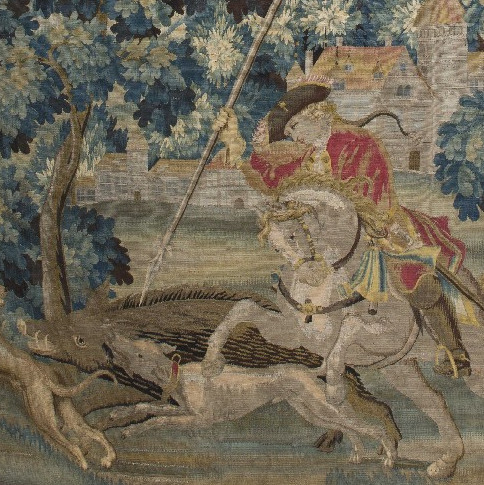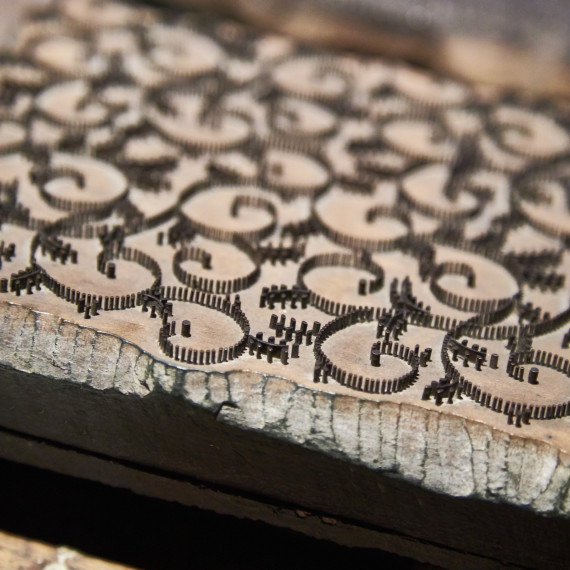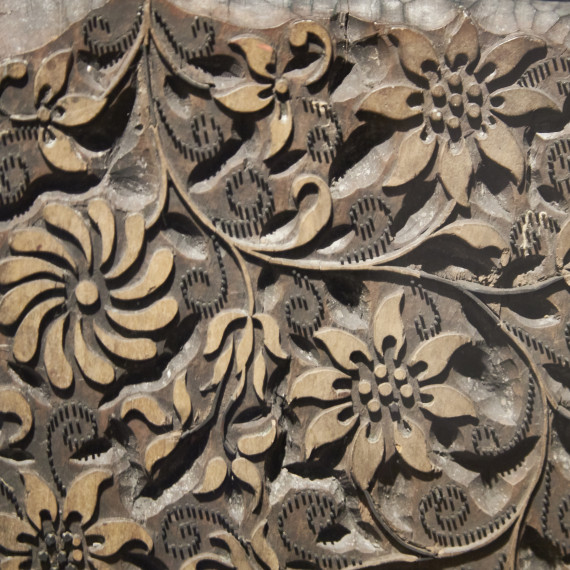Printing and Gobelins
 'Boar Hunt' tapestry
'Boar Hunt' tapestry
Erlangen, 18th century
This tapestry was originally part of the furnishings of Mainau Palace, and in 1995 it became possible to acquire it together with two further pieces of tapestry manufactured in Erlangen.
Its current state of preservation bears witness to the ups and downs of history that many tapestries were exposed to. The image has been cropped on the left-hand side, probably in order to fit the tapestry to a smaller wall panel. Tears and holes resulting from moth damage were only improperly repaired, or not at all. Only the left-hand part of the severed borders has been preserved.
The de Chazaux 'Court Tapissiers'
The term 'Gobelin', commonly used to mean 'tapestry' in Germany since the 19th century, originates from the French 'Gobelin' state tapestry manufacture. In 1662, this manufacturing workshop was established during the reign of Louis XIV on the former premises of the Gobelin family of dyers, whose name was transferred to the tapestry workshop. With its royal tapestry manufacture, Paris became a leading centre for tapestry production, and its pictorial tapestries – tapisseries in French – developed into the most magnificent prestige objects owned by absolutist courts.
Erlangen tapestries
In 1701, Jean de Chazaux from the French carpet weavers' town of Aubusson founded a Tapetenfabrik ('wall hanging factory') in Erlangen, which existed until about 1770. Around 25 tapestries made in this workshop have been preserved, among them six in the former Prince-Bishop's palace in Passau, and a second series of six pieces in the palace of the Princes of Thurn and Taxis in Regensburg.
Mostly modelled on French designs, these pictorial tapestries show allegorical and mythical scenes – often, following contemporary tastes, as grotesques – but also rural motifs and hunting scenes. Attributing these unsigned tapestries to a maker is mainly based on stylistic features, especially on the similarities in the design of the borders, which are considered the most original creations and trademarks of individual manufacturing workshops.
Pictorial tapestry techniques
From a technical point of view, making a tapestry is related to weaving, as it is also based on the principle of the perpendicular crossing over and under of warp and weft threads. The work begins with stretching the parallel warp threads onto the loom, which run vertically on a high-warp loom and horizontally on a low-warp loom. The mosaic-like picture is created by weaving differently coloured weft threads through the warp only as far as they are needed to create the desired image. The weft is beaten together tightly so that the warp disappears and the fabric is strengthened.
Tapestry weavers used 'cartoons' to guide them, model drawings on carton with gridlines, which were full-sized representations of the edges of the colour fields that made up the pattern. On low-warp looms, the cartoon is a mirror-image of the design and is placed directly under the warp so that the weaver is working on the reverse side of the fabric. On high-warp looms, on the other hand, the outlines and colour fields are transferred directly to the warp.
 Printing blocks from an Erlangen dyer's workshop
Printing blocks from an Erlangen dyer's workshop
19th century
In order to enable precise printing, the hand models have repeat pins at the corners. The pattern is carved into the wood or is formed by metal pins.
East Indian style fabric printing
The rapidly expanding imports of colourfully patterned Indian Cottons in the 17th century changed European fashion. While only woven colour patterns and cloth printed with oil paint had been known until then, colourfast exotic indiennes (lit. 'Indians'), colourful block-printed cottons, became fashionable at this time, which were used in clothing, upholstery, rugs, and interior decoration.
During the last quarter of the 17th century, and only after some failures, the manufacture of printed fabric east-Indian style became successful also in Europe. Although the first European manufacturing workshops tried to keep their trade secrets, fabric printing became more widespread in the first half of the 18th century. Innovations were essentially based on two techniques, namely Zitzkattundruck (multicolour cotton cloth printing), which is a mordant printing technique, and Blaudruck ('blue printing'), a resist printing technique using indigo dye.
Multicolour cotton printing
Zitzkattundruck (printing multiple colours on fine cotton cloth) was based on madder (dyer's madder), a natural red dye. Black, as well as different shades of red and violet all the way to brown were achieved in a two-step process: printing different, mostly mineral-based mordants onto the fabric, then dyeing in the hot madder dye stock, whereby several colours emerged simultaneously. Yellow, green and blue tones, on the other hand, were usually applied with a brush (Schilderfarben – 'painting colours'). The bright, multicoloured Zitzkattun fabrics were only produced in manufacturing workshops that used some degree of division of labour.
Indigo resist printing
Cotton as well as linen fabrics were suitable for indigo resist printing. The indigo dyestuff was imported from India and was turned into its water-soluble form (verküpt - lit. 'vat-readied') through a chemical reduction process. A paste-like protective substance called Papp ('pap') – the resist – was used for printing. When subsequently dyed blue in the cold indigo dye stock, the areas printed with 'pap' are protected from the effects of the indigo dye – they 'resist'. Indigo resist printing could be carried out on an artisanal level and was widespread as a rural industry in the 19th century.
 Print models from an Erlangen whitework
Print models from an Erlangen whitework
19th century
The Hartner brothers' manufacturing workshops
The first cotton printing workshop in Erlangen was established following the model of Hamburg manufacturing workshops by master dyer Peter Hartner in the middle of the 18th century. In 1751, and despite the protests of some fellow master dyers, he obtained a Margravial privilegium cum iure prohibendi, which assured him and his three sons monopoly status in the Bayreuth Unterland (lowlands) for 15 years and was extended again in 1770.
After their father's death in 1756, the Hartner brothers continued the business successfully as three independent enterprises. They mainly worked for external agents who commissioned both indigo-resist printed and multicoloured Zitzkattun cloth.
The most important of the three enterprises was that of Johann Achatius Hartner, who continued to preside over the company's historic headquarters in Goethestraße. In 1792, his manufacturing workshop, organised by division of labour, employed a total of 276 workers, including Coleurmacher (‘colour makers’), printers, dyers, smoothers, and tailors, as well as around 150 Schildermädchen ('painting maids').
Weakened by the demand crisis during the Napoleonic Wars, Erlangen cotton printers didn't manage to catch up with the innovations brought about by the beginning industrial revolution.
< Previous chapter | Next chapter >
